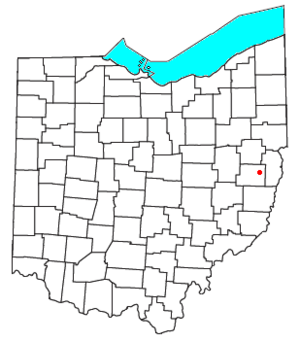Pittsburgh Junction, Ohio facts for kids
Pittsburgh Junction is a small, quiet place in Harrison County, Ohio, in the United States. It's known as an unincorporated community. This means it's a group of homes and businesses that don't have their own local government, like a city or town does. Instead, it's part of a larger area called Green Township.
Contents
What is an Unincorporated Community?
An unincorporated community is a place where people live close together, but it's not officially a city or a village. It doesn't have its own mayor or city council. Instead, the county or township government helps manage things like roads and services for the area. Pittsburgh Junction is one such community in Ohio.
Why is it Called Pittsburgh Junction?
The name "Pittsburgh Junction" comes from its history with railroads. A "junction" is a place where different railroad tracks meet or cross. This specific spot was important because it marked where the tracks of two major railways connected.
One railway was the Pittsburgh and West Virginia Railway. The other was the Wheeling and Lake Erie Railway (1916–88). For many years, this junction was a busy hub where trains would switch tracks or change directions. This made the area important for transporting goods and people.
Where is Pittsburgh Junction Located?
Pittsburgh Junction is located in the western part of Green Township. It sits in Harrison County, Ohio. The area is about 1,146 feet (or 349 meters) above sea level.
You can find it not far from where two important roads meet. These roads are U.S. Route 22 and State Route 151. These routes help connect Pittsburgh Junction to other towns and cities in Ohio.
Railroads and Their Importance
Railroads played a huge role in developing the United States. They helped move raw materials, finished products, and people across long distances. Towns and communities often grew up around railroad junctions, just like Pittsburgh Junction did. These junctions were vital for trade and travel, connecting different parts of the country. Even today, railroads are important for moving goods, though passenger travel is less common in many areas.


